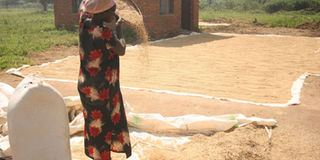Government mulls banning rice imports

A rice grower dries rice in Butalejja. FILE PHOTO
What you need to know:
The ban on rice imports is intended to boost local production, Dorothy Nakaweesi writes.
Uganda has more mills than rice to process, a situation that has left players in the industry in a tight spot as government plans to stop importing the unprocessed grains.
A new study on the size of the rice market in Uganda found that, the country has a daily milling capacity of 7,158 metric tonnes. This implies that it takes only 38 days to mill paddy rice that is currently grown in Uganda.
This means if it were not for the imports of unprocessed rice, the mills would be redundant for the remaining 327 days of the year.
Third deputy Prime Minster, Moses Ali who officially launched the report said, “The ban on importats is intended to protect farmers and increase our domestic production.”
He said the country’s domestic production target should double from the current 1.5 tonnes to 3 tonnes per hectare.
“Last year, Uganda alone imported rice worth some $120m (Shs450b). That money should have gone to our farmers and millers to improve domestic production and create more jobs,” Mr Ali added.
Responding to the looming ban, Mr Philip Idro, the chairperson of the Rice Millers Council of Uganda said, “Millers have set up factories to process locally produced rice. Unfortunately, farmers are not producing enough. We want government and the private sector to help out on this.”
Mr Idro added that investors have put in a lot of money to set up mills and if they stop operating, their mills will be taken away.
“This is why we are asking government to allow us (millers) import a bit of rice from Pakistan and other areas at least for the next two years to prepare for this action. This will give time to farmers to produce enough,” Mr Idro pleaded.
He urged the ministry of agriculture to train farmers to grow more rice which will be supplied to the millers.
Imports
According to statistics from Uganda Revenue Authority and International Trade Centre (ITC), Uganda’s imports have increased by 71.4 per cent in the last 10 years.
In 2008, the country imported a total of 59,988 tonnes. This has since increased to 210,102 tonnes recorded in 2017.
Rice imports into the country mainly come as raw (brown & paddy) and final refining happens in the country. It is parked and re-distributed into consumption areas.
Exports
Much as Uganda’s production is not enough to run the mills throughout the year, the country also exports some.
Data indicate an increase in the rice exports from 33,757 tonnes in 2008 to 71,890 tonnes in 2017.
“Rice exports are mainly done as white rice which is exported to DRC and South Sudan. Part of the exports are from the local production and another part is from the imports,” Mr Haam Rukundo, the team leader at Rhamz International – a multidisciplinary consultancy that conducted the research, said.
Mr Rukondo said their findings show that Uganda’s imports of rice for the year ending December 2017 were 210,102 tonnes of paddy. Of this volume, 59,852 tonnes of paddy were re-exported to neighbouring countries.
“In the same year, the country exported 71,890 tonnes of paddy equivalent from the locally produced rice. Therefore the imports netted 78,360 tonnes of paddy rice,” Rukondo added.
Due to the fact that the net imports also reflect informal exports which were not confirmed by this study, net imports range between 78,360 tonnes and 150,000 tonnes of rice.




